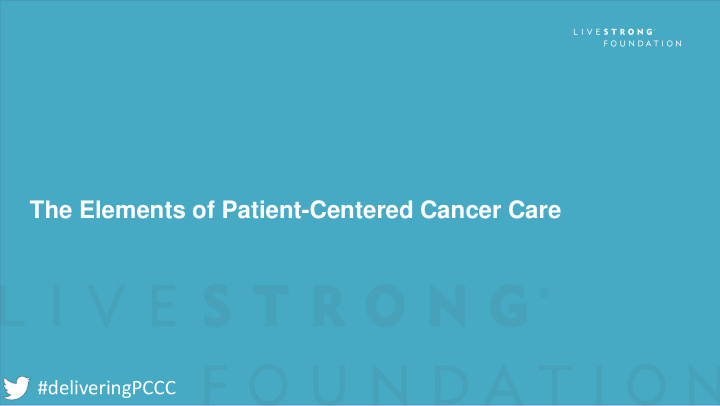



The Elements of Patient-Centered Cancer Care #deliveringPCCC
What We Have Prepared A working definition of patient-centered cancer care A list of 23 elements of patient-centered cancer care A foundation for communication, collaboration, and action
Definition Patient-centered care is respectful of and responsive to individual patient preferences, needs, and values, and ensures that patient values guide all clinical decisions.
Additionally, Patient-Centered Cancer Care: • Considers the patient as a whole person , beyond their disease, from the time of diagnosis through the balance of their life; • Is respectful of the patient’s preferences, needs, and values related to the involvement of their family and friends in their care • Empowers the patient to participate in their care in a way that is consistent with their preferences, needs, and values • Requires that multiple levels of the cancer care delivery are designed to accommodate the needs of patients and caregivers, acknowledging that the care delivery system must support providers to function effectively.
Definition
• Cancer care which incorporates best practices • The needs, preferences, and values and new evidence as they are generated • Emotional and psychosocial support for the patient and of the patient – including • their family and caregivers Coordinated, integrated care across multiple sociocultural, socioeconomic, and disciplines within and outside of oncology spiritual – are continually assessed Understanding the Whole Person • Supportive care, including preventive care (e.g., care to (including primary care and allied health Coordinating/Integrating Care and serve as the foundation of care professionals) support nutrition, physical activity) and to promote self- decisions management • Access to genetic testing and counseling • Architecture or a built • Access to complimentary and alternative medicine • Education, support, and training for all staff to environment that is designed to support the implementation and provision of promote a patient-centered • Access to palliative care patient-centered cancer care experience • Continuous quality improvement and performance • Support to establish and/or maintain healthy sleep both measurement, including the integration of new at home and in the inpatient setting standards as they evolve • A technology-enabled learning health care system that • Accessible, timely, clear, and effective communication • Counseling and support for managing practical uses data to capture PROs to support the provision of concerns related to cancer such as access to between all parties engaged in the care of the patient and, care, both during and between clinical encounters transportation; financial needs; insurance; child with the patient’s permission, their family and caregivers • Providers, patients, and individuals the patient grants care; and advanced directives permission to have timely and no-cost access to up-to- date medical information (including access to the • Access to family planning services, such as patient’s medical record ) fertility preservation, reproductive assistance, • Survivorship Care Planning, including provision of and adoption support treatment summaries, survivorship care plans, and psychosocial care plans • • • • • Providers who identify and Education and support to Reasonable wait times before A positive therapeutic alliance between Access to comparative information communicate realistic goals to empower the patient’s appointments begin and to secure patients, their family, their caregivers, about the costs of care before care the patient and their family and preferred level of participation future appointments and the health care team is provided caregivers in informed decision making Empowering Patients
To me, a place can say they’re patient -centered , but it doesn’t mean anything if they can’t back it up . Dr. Abby Prestin, age 34 Lymphoma survivor
Recommend
More recommend